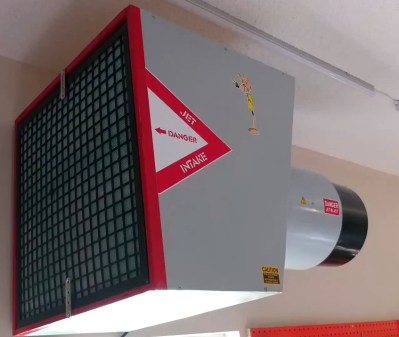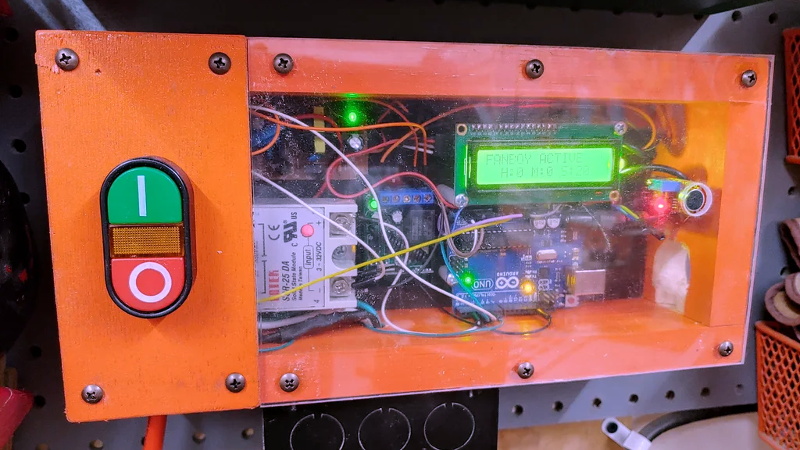Whether you’re using a soldering iron or a table saw, ventilation in the shop is important. Which is why [Atomic Dairy] built a monster air cleaner called the Fanboy that looks like it should be mounted under the wing of an F-15. Realizing a simple switch on the wall wouldn’t do this potent air mover justice, they decided to build a sound activated controller for it.
 It’s certainly an elegant idea. The sound created once they kick on their woodworking tools would be difficult to miss by even the most rudimentary of sound-detection hardware. At the most basic level, all they needed was a way for an Arduino to throw a relay once the noise level in the room reached a specific threshold.
It’s certainly an elegant idea. The sound created once they kick on their woodworking tools would be difficult to miss by even the most rudimentary of sound-detection hardware. At the most basic level, all they needed was a way for an Arduino to throw a relay once the noise level in the room reached a specific threshold.
Of course it ended up getting a bit more complicated than that, as tends to happen with these kinds of projects. For one, the sound doesn’t directly control the solid state relay used in the fan controller. When the microphone equipped Arduino detects enough noise, it will start a timer that keeps the fan running for two hours. If the tool keeps running, then more time gets added to the clock. This ensures that the air in the room is well circulated even after the cutting and sanding is done.
[Atomic Dairy] also added a few additional features so they could have more direct control over the fan. There’s a button to manually add more time to the clock, and another button to shut it down. There’s even support for a little wireless remote control, so the fan can be operated without having to walk over to the control panel.
We’ve seen some impressive air circulation and dust collection systems over the years, but finding a way to elegantly switch them on and off has always been a problem given the wide array of tools that could be in use at any given time. Sound activation isn’t a perfect solution, but it’s certainly one we’d consider for our own shop.
















Could use one for the bathroom too!
Years ago I shared an office with a guy who was notorious for having all of his friends stop by all day long, creating a major distraction in the process by constantly chatting instead of doing work. He was also known for over-embellishing these conversations, as they usually led to lengthy stories (that almost always involved bragging).
I badly wanted to make a system like this (to ease my irritation) that would trigger a ‘bullshit’ alarm above a certain threshold of noise level versus time (the conversations usually got louder as each participant tried to ‘out man’ the other.. )
Sadly, work came first and I never found the time. Plus, it probably wouldn’t have helped the office situation..
Given that soldering irons are notoriously silent, one may want to use the soldering iron MP3 hack shown on here the other month to loop a sample of PeeWee Herman going Lalalala or something…
Most of the usual Weller (or similar) temperature controlled irons uses a transformer to step down to something like 24V. A pickup coil next to the base of the soldering station would be able to know if the iron is on without modifications unless you like using a singing iron…
Just need to shout “I’m using the soldering iron!!” And it’ll turn on 👍
Cool, but hear me out:
Why not monitor the power usage of the tool(s) instead of the noise level?
Because then you’d have to connect all of the tools in the shop to the fan controller. Or at least, the fan controller would have to tap the line that powers the entire shop.
But by monitoring for the sound of tools, you can support an arbitrary number of tools without having to connect them to anything. Even battery powered tools, which are increasingly popular even in a shop where their portability isn’t strictly required.
Just an amp clamp on the main supply and you can detect tools starting up, even less noisy ones like solder pots, ovens etc.
Not to mention the refrigerator. Or maybe we didn’t want to start the fan everytime the refrigerator started.
I don’t want a blast of cold air when running my space heater when wrenching on bikes man.
I can’t be alone in listening to really loud music while I work. Wouldn’t there be issues with false starts?
I would tune mine up to trigger on loud farts. Another air quality issue in the shop taken care of.